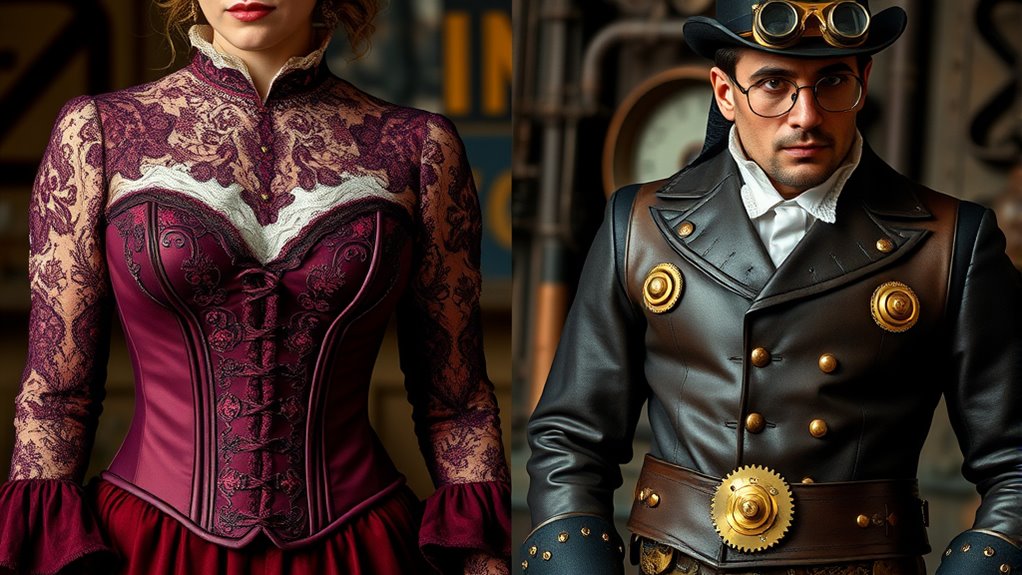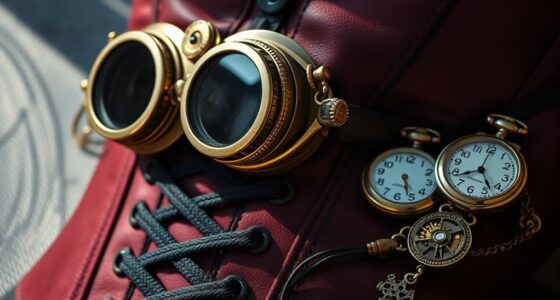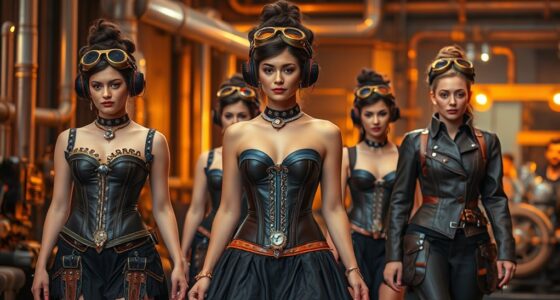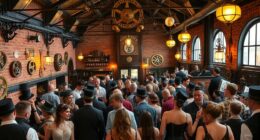Victorian fashion reflects 19th-century elegance with tailored garments, high necklines, and modest, polished looks centered on craftsmanship and tradition. In contrast, steampunk reimagines Victorian style with industrial and punk influences, featuring layered, customized outfits, mechanical accessories, and a bold, inventive aesthetic. While Victorian fashion emphasizes subtle refinement and uniformity, steampunk encourages creativity, personality, and exploration through bold metallic details and eclectic textures. Explore further to see how these styles truly contrast and connect.
Key Takeaways
- Victorian fashion emphasizes modesty, tailored garments, and polished elegance, while steampunk incorporates industrial influences and a rebellious aesthetic.
- Victorian clothing features structured silhouettes with corsets and high necklines; steampunk adds layered, customized, and eclectic pieces.
- Accessories in Victorian style are understated and refined; steampunk accessories are bold, mechanical, and often metallic.
- Victorian fashion focuses on tradition and craftsmanship; steampunk emphasizes creativity, personalization, and a mix of vintage and futuristic elements.
- Victorian design maintains a historical, formal look, whereas steampunk blends Victorian elements with sci-fi, fantasy, and industrial motifs.

Have you ever wondered how Victorian fashion differs from steampunk style? The answer largely lies in their origins and the way they express themselves through clothing. Victorian fashion, rooted in the 19th century, focuses on elegance, modesty, and intricate detailing. It’s characterized by tailored garments, high necklines, long skirts, and a structured silhouette. Corset styles during this era serve as a defining feature, emphasizing a narrow waist and creating an hourglass shape. These corsets are often made of heavy fabrics like whalebone, steel, or cotton, with detailed lacing and boning that showcase craftsmanship. In contrast, steampunk fashion takes Victorian elements and reimagines them with a futuristic twist inspired by science fiction and fantasy. It blends Victorian aesthetics with industrial and punk influences, resulting in a more eclectic and rebellious look.
When it comes to accessory choices, Victorian fashion leans toward understated elegance. Women might wear lace gloves, delicate brooches, and pearl necklaces, while men opt for pocket watches, top hats, and cravats. Accessories are carefully chosen to complement the refined, polished appearance of the era. In steampunk style, accessories become more playful and inventive. You’ll find goggles, mechanical gears, pocket watches with intricate designs, and metallic jewelry that hint at a steampunk’s love for machinery and innovation. These accessories aren’t just decorative; they tell a story of adventure and exploration, often featuring brass and copper accents, rivets, and clockwork motifs. This style encourages personalization, so you might see layered necklaces, corsairs, or even steampunk weaponry integrated into outfits, creating a sense of rugged fantasy.
While Victorian fashion emphasizes uniformity and tradition, steampunk embraces creativity and individuality. Corset styles in Victorian clothing are primarily about silhouette and modesty, whereas in steampunk, they often function as statement pieces that can be highly customized with embellishments and accessories. The accessories in Victorian fashion aim for subtle refinement, whereas steampunk accessories serve as bold expressions of personality and innovation. Both styles value craftsmanship, but steampunk puts a greater emphasis on mixing different textures, metals, and vintage components to craft a look that’s both nostalgic and imaginative. So, if you’re looking to understand the core difference, think of Victorian fashion as a polished, historical tribute, and steampunk as a creative remix that invites you to invent your own story through clothing.
Frequently Asked Questions
Can Victorian Fashion Be Considered Sustainable Today?
Yes, Victorian fashion can be considered sustainable today if you focus on sustainable fabric choices and vintage clothing reuse. By selecting eco-friendly materials and repurposing vintage garments, you reduce waste and lessen environmental impact. Embracing Victorian-inspired styles encourages thoughtful consumption and preserves historical craftsmanship. This approach aligns with sustainability principles, allowing you to enjoy elegant fashion while supporting eco-conscious practices.
How Do Accessories Differ Between Victorian and Steampunk Styles?
You’ll notice that Victorian accessories often feature delicate, ornate designs like lace gloves and pearl necklaces, emphasizing elegance. In contrast, steampunk accessories incorporate mechanical jewelry with gears and cogs, giving a vintage industrial vibe. Leather accessories are common in both styles, but steampunk favors rugged leather belts and goggles, adding a utilitarian touch. These differences highlight the Victorian focus on refinement versus steampunk’s emphasis on innovation and adventure.
Are There Specific Fabrics Unique to Victorian or Steampunk Fashion?
You’ll find that Victorian fashion favors rich fabrics like silk, velvet, and brocade, which symbolize elegance and status through fabric innovation. Steampunk, however, incorporates more rugged textiles like leather, canvas, and tweed, reflecting industrial influences. While Victorian fabrics emphasize opulence, steampunk textiles symbolize adventure and craftsmanship. Both styles use fabrics to tell stories, but Victorian fabrics are more about luxury, whereas steampunk fabrics highlight durability and innovation.
How Has Steampunk Influenced Modern Fashion Trends?
You’ll notice that steampunk has markedly influenced modern fashion trends by embracing an industrial influence and a retro revival. You might see this in the way designers incorporate gears, leather, and metallic accents into everyday wear, blending vintage aesthetics with futuristic elements. This fusion creates a unique style that appeals to those seeking a bold, imaginative look, making steampunk-inspired fashion a popular choice for cosplay, festivals, and alternative streetwear.
Can Victorian or Steampunk Fashion Be Worn Daily?
You can definitely wear Victorian or steampunk fashion daily, but beware of practicality concerns. While these styles make striking statements, they often lack modern comfort and require careful attention to historical accuracy. Picture yourself in a corset or layered gears—eye-catching, yet potentially restrictive. If you adapt elements thoughtfully, blending vintage details with everyday practicality, you’ll enjoy a unique look that turns heads without sacrificing comfort.
Conclusion
So, there you have it—Victorian and steampunk fashion, worlds apart yet strangely obsessed with gears and ruffles. One’s all about proper elegance, while the other’s about pretending you’re a Victorian inventor with a flair for the dramatic. Whether you prefer corsets or goggles, just remember: fashion’s never been about comfort, only making sure you look fabulous while tripping over your own bustle or brass accessories. Now go forth and dress like you mean it—steampunk or Victorian, your call!









